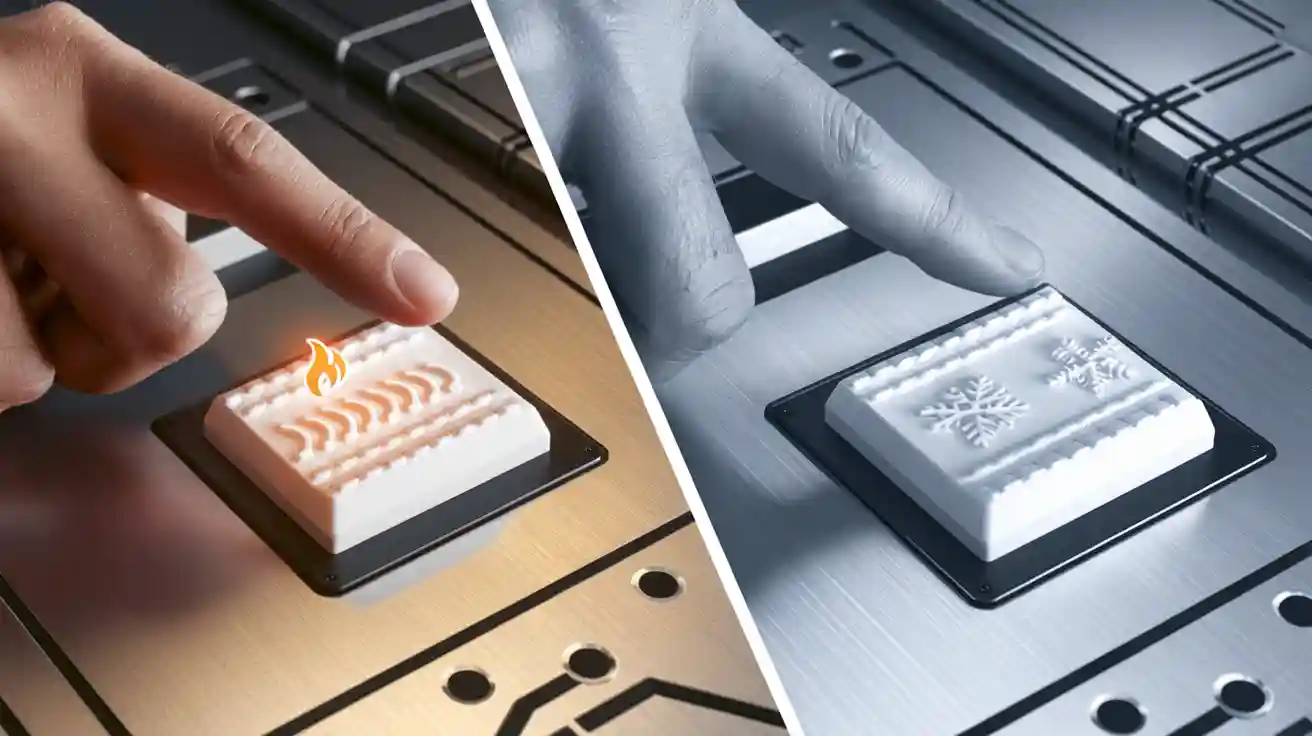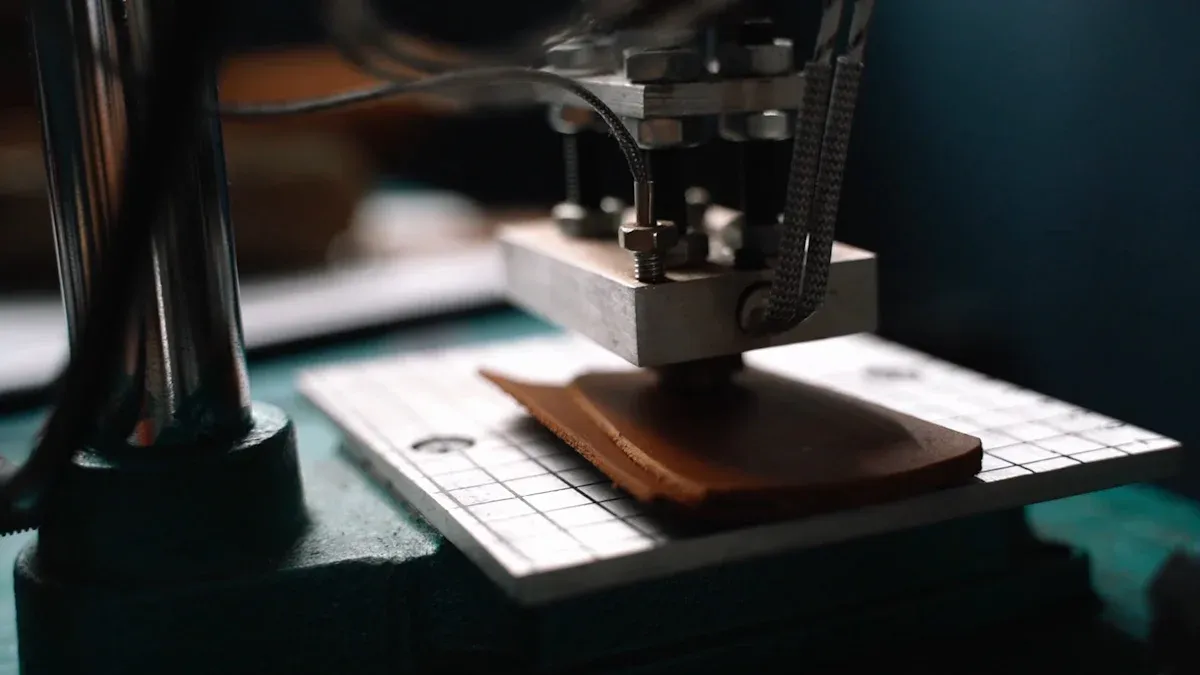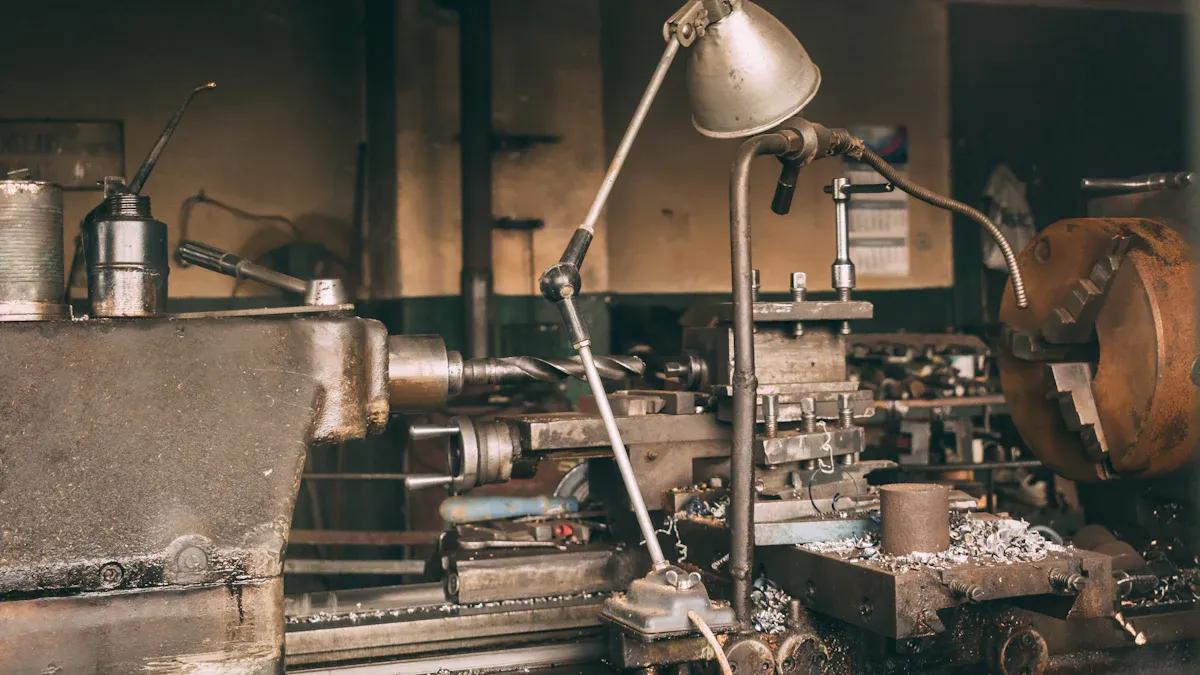
What Sets Hot and Cold Embossing Apart in Membrane Switches
What Sets Hot and Cold Embossing Apart in Membrane Switches

The primary difference between hot and cold embossing membrane switch processes lies in the application of heat during forming. This choice plays a critical role in membrane switch design, influencing tactile response, durability, and visual appeal. Manufacturers select the embossing membrane switch method to enhance user interface design and achieve specific functional goals. Every detail in membrane switch design, including the embossing process, shapes user satisfaction and product reliability.
Key Takeaways
- Hot embossing uses heat and pressure to create sharp, durable raised features that improve tactile feedback and suit high-end membrane switches.
- Cold embossing shapes overlays using only pressure, offering faster production, lower costs, and safer handling for sensitive materials.
- Choosing between hot and cold embossing depends on design complexity, production volume, cost limits, material type, and desired tactile feel.
- Hot embossing supports detailed, complex shapes and long-lasting performance, while cold embossing works well for simple designs and quick runs.
- Matching the embossing method to the membrane switch’s purpose ensures better user experience, durability, and product reliability.
Embossing Membrane Switch Overview
What Is Embossing?
Embossing creates raised or recessed features on a material’s surface. In manufacturing, this process uses a die or mold to press specific shapes into thin films or sheets. The result is a tactile pattern that stands out from the rest of the surface. Overlay embossing often appears in user interfaces, where designers want to highlight buttons or symbols. This technique helps users locate controls by touch, even without looking. Embossing membrane switch designs rely on precise pressure and alignment to ensure consistent results.
Note: Overlay embossing can improve both the look and feel of a product, making it more intuitive for users.
Purpose in Membrane Switches
Manufacturers use embossing membrane switch techniques to enhance both function and appearance. Raised keys or symbols provide clear tactile feedback, which helps users confirm each press. This feedback reduces errors and increases satisfaction. Embossing also allows designers to create visually distinct areas, improving navigation on complex panels. In addition, the process can extend the lifespan of a membrane switch by protecting printed graphics from wear. Many industries, such as medical devices and industrial controls, depend on these benefits to deliver reliable performance.
A few key purposes of embossing in membrane switches include:
- Improving tactile response for better usability
- Highlighting important keys or icons
- Protecting underlying graphics from abrasion
- Supporting brand identity through custom shapes
Careful selection of embossing methods ensures that each membrane switch meets its intended application and user expectations.
Hot Embossing Process

How It Works
Hot embossing uses both heat and pressure to shape materials like PET (polyester) and PC (polycarbonate). The process starts with a custom mold or die that matches the desired button or symbol shape. Operators place the film for the embossing membrane switch between the heated die and a flat surface. The machine applies pressure while the die heats up. The heat softens the material, allowing the die to press a raised or recessed pattern into the surface. After cooling, the material keeps its new shape. This method creates crisp, defined features that stand out on tactile membrane switches.
Features and Benefits
Hot embossing offers several advantages for tactile membrane switches. The heat allows for deeper and more precise embossing, which improves tactile feedback. Users feel a clear response when pressing a button. This process also increases the durability of the raised areas. The heat bonds the material, making it less likely to crack or wear down over time. Hot embossing supports complex shapes and fine details, which helps designers create unique and attractive interfaces. The finished product often looks more professional and feels more satisfying to use.
Tip: Hot embossing can enhance both the look and feel of tactile membrane switches, making them ideal for high-end applications.
Applications and Limits
Manufacturers often choose hot embossing for products that require strong tactile feedback and long-lasting performance. Medical devices, industrial controls, and consumer electronics all benefit from this process. Hot embossing works best with materials that can handle heat, such as PET and PC. However, it may not suit every project. The process takes more time and costs more than cold embossing. It also requires special equipment and careful temperature control. For large production runs or designs with detailed features, hot embossing remains the preferred choice for tactile membrane switches.
Cold Embossing Process

How It Works
Cold embossing shapes membrane switch overlays using only pressure, without applying heat. Operators place the overlay material, such as polyester or polycarbonate, between a die and a matching counter-die. The press then applies force, creating raised or recessed features. This method relies on the flexibility of the material to form the desired shapes. Cold embossing works well for both tactile membrane switches and non-tactile membrane switches, depending on the design. The process does not alter the chemical structure of the material, which helps maintain its original properties.
Note: Cold embossing offers a straightforward approach for creating raised features, especially when working with thin or sensitive materials.
Features and Benefits
Cold embossing provides several advantages for manufacturers. The process requires less specialized equipment, which reduces setup costs. Production speed increases because there is no need to wait for materials to heat or cool. This method suits high-volume runs and projects with tight deadlines. Cold embossing also works well for non-tactile membrane switches, where the design does not require a pronounced button feel. However, it can also support tactile membrane switches, though the tactile feedback may feel softer compared to hot embossing. The absence of heat lowers the risk of material warping or discoloration.
- Lower production costs
- Faster turnaround times
- Suitable for sensitive materials
- Consistent results for both tactile and non-tactile designs
Applications and Limits
Manufacturers often choose cold embossing for non-tactile membrane switches in applications where visual cues matter more than tactile response. This process fits well in consumer electronics, appliances, and control panels that use non-tactile overlays. Cold embossing also finds use in tactile membrane switches for projects that prioritize cost and speed over deep tactile feedback. However, the process cannot achieve the same depth or sharpness as hot embossing. Designers should consider cold embossing when they need efficient production, lower costs, and compatibility with a wide range of materials.
Membrane Switch Types Comparison
Process Differences
Hot embossing and cold embossing use different methods to create raised features on membrane switch overlays. Hot embossing relies on both heat and pressure. Operators use a heated die to soften the material, then press it into the desired shape. This process requires specialized equipment, including a die box, stamping machine, and cooling block. Setup can take several hours, and die creation often adds one to two weeks to the production timeline. Hot embossing works best for flat, rigid surfaces and typically suits mid to high production volumes due to the upfront investment in custom dies.
Cold embossing, on the other hand, uses only pressure to form shapes. Operators place the overlay material between a die and counter-die, then apply force. This method does not require heat or electricity. Setup is simple and quick, often taking just a minute. Cold embossing stations need minimal tools, such as scissors and letter dies, making the process portable and easy to manage. Manufacturers can start production immediately, which speeds up turnaround times and reduces initial costs.
Tip: Cold embossing offers greater flexibility for curved or irregular surfaces, while hot embossing provides more defined shapes for flat overlays.
Result Differences
The results of hot and cold embossing differ in several key areas. Hot embossing produces deeper, sharper, and more durable raised features. The heat allows the material to form crisp edges and maintain its shape over time. This method enhances tactile feedback, making it ideal for applications where users need to feel each button press. Hot embossing also supports complex designs and fine details, which can improve the appearance and usability of the membrane switch.
Cold embossing creates raised features with softer edges and less depth. The tactile response feels gentler, which may suit non-tactile overlays or applications where visual cues matter more than physical feedback. Cold embossing works well for both tactile and non-tactile membrane switch types, but it cannot achieve the same level of detail or durability as hot embossing. The process also reduces the risk of material warping or discoloration, making it suitable for sensitive overlays.
Manufacturers often choose cold embossing for projects that require fast production and lower costs. Hot embossing remains the preferred choice for high-end products that demand strong tactile feedback and long-lasting performance.
Pros and Cons Table
| Feature | Hot Embossing | Cold Embossing |
|---|---|---|
| Cost | High initial die and equipment costs; more cost-effective at mid to high volumes | Lower initial costs; no expensive dies required |
| Production Time | Longer setup (1-2 weeks for die creation); slower start | Minimal setup (~1 minute); immediate production |
| Defect Rates | Traditional method; potential safety risks from hot dies | Lower defect rates; safer with no heat involved |
| Setup Complexity | Requires multiple tools and equipment | Simple setup; minimal tools needed |
| Surface Flexibility | Limited to flat, rigid surfaces | Works on flat and curved surfaces |
| Portability | Equipment is bulky and not portable | Highly portable; fits in a small bag |
| Tactile Feedback | Deep, crisp, and durable tactile response | Softer, less pronounced tactile feel |
| Detail and Appearance | Supports complex, fine details | Less detail; best for simple shapes |
| Suitability | Best for high-end, tactile applications | Ideal for non-tactile overlays and fast production |
Note: Manufacturers should match the embossing process to the specific needs of their membrane switch types, considering factors like cost, production speed, and the importance of tactile feedback.
Membrane Switch Design Choices
Decision Factors
Selecting the right embossing process for membrane switch design requires careful evaluation of several factors. Each project presents unique requirements, and the choice directly impacts the final product’s performance and user satisfaction.
- Design Complexity: Hot embossing supports intricate shapes and fine details. Cold embossing works best for simple, straightforward designs.
- Production Volume: High-volume runs often justify the higher setup costs of hot embossing. Cold embossing suits smaller batches or projects with tight deadlines.
- Cost Constraints: Hot embossing involves higher initial investment in dies and equipment. Cold embossing offers lower upfront costs and faster setup.
- Material Compatibility: Some materials, such as certain polyesters, may not tolerate high heat. Cold embossing provides a safer option for sensitive overlays.
- Tactile Feedback Needs: Applications that demand strong tactile response, such as industrial controls, benefit from hot embossing. Cold embossing delivers a softer feel, which may suit non-tactile overlays.
- End-Use Environment: The environment where the membrane switch will operate influences the choice of embossing and surface finish. For example, outdoor or industrial settings may require textured finishes for durability, while consumer products may benefit from glossy or velvet finishes for visual appeal.
Tip: Always match the embossing process to the specific needs of the membrane switch design to ensure optimal performance and user satisfaction.
| Embossing / Finish | Description | User Experience / Environment Impact |
|---|---|---|
| Dome Embossing | Smooth, rounded, bubble-like shape | Provides intuitive tactile feedback, ideal for switch-heavy environments |
| Rim Embossing | Raised perimeter with flat center | Highlights icons or text, maintains visibility where clarity is important |
| Standard Pad Embossing | Flat-topped raised surface | Defines button boundaries, supports straightforward interaction |
| Braille Embossing | Raised Braille characters | Essential for accessibility, improves usability for visually impaired users |
| Velvet Finish | Soft, matte appearance | Reduces glare and fingerprints, ideal for high lighting or frequent handling |
| Textured Finish | Subtle tactile feel, improved grip | Enhances durability and tactile feedback in demanding or outdoor environments |
| Glossy Finish | Smooth, polished surface | Enhances graphic vibrancy, best for consumer-facing products |
| Reflective Finish | Increases visibility in low-light settings | Useful for safety-critical, transportation, or emergency equipment |
Hot and cold embossing each bring unique strengths to membrane switch design. Hot embossing creates sharper tactile features and suits high-end applications. Cold embossing offers speed and cost savings for simpler projects. Careful process selection ensures membrane switch design meets user needs and industry standards. Manufacturers should evaluate project goals, material compatibility, and desired tactile feedback before choosing an embossing method.
FAQ
What materials work best for hot embossing in membrane switches?
Polyester (PET) and polycarbonate (PC) films perform best in hot embossing. These materials withstand heat and pressure, allowing for crisp, durable raised features. Manufacturers select them for their stability and ability to retain detailed shapes.
Tip: Always verify material compatibility before starting production.
Can cold embossing achieve the same tactile feedback as hot embossing?
Cold embossing creates raised features, but the tactile response feels softer and less defined. Hot embossing produces deeper, sharper tactile feedback. Designers choose the process based on the required user experience.
Does embossing affect the lifespan of a membrane switch?
Yes. Hot embossing increases durability by bonding the material and protecting graphics. Cold embossing maintains material integrity but may offer less protection for high-wear applications.
Which embossing process offers faster production times?
Cold embossing provides faster setup and production. It requires minimal equipment and no heating or cooling steps. Manufacturers often use it for projects with tight deadlines or high-volume needs.
Are both embossing methods suitable for custom shapes and branding?
Hot embossing supports complex, detailed shapes and custom branding. Cold embossing works best for simple designs. For intricate logos or unique button shapes, hot embossing delivers superior results.

Top Membrane Switches for Home Electronics Projects in 2025
You can elevate your home electronic membrane switch project in 2025 with standout models such as the 4×4 Matrix 12 Keys Keypad from SOUSHINE, the rgb-enabled strip switches from Molex, and custom graphic switches by Panasonic. These switches offer slim profiles and reliable performance, making them easy to integrate into your DIY setup. You gain ...

Top tips for fixing PS4 controller conductive film keypads
Are you frustrated because your PS4 controller buttons have stopped working? You are not alone. Many gamers experience issues with the conductive film keypad for ps4. Button failures often happen because of dirt, debris, or rough handling. Take a look at the most common causes: Cause Description Dirt and debris Accumulation in button crevices can ...

Top Membrane Switch Companies Leading the Industry in 2025
You see a dynamic market shaping the future of membrane switch technology. Leading companies like Molex, SOUSHINE, YU AN Electronics, TE Connectivity, Honeywell, Omron, Mitsubishi Electric, Panasonic, Industrial Print Technologies, SCHURTER, XYMOX, Douglas Corp, Dyna-Graphics, ELO Touchscreens, UTC, LUNFENG Technology, and Fujikura drive growth with innovation and global reach. Choosing the right membrane switch company ...
Contact us online